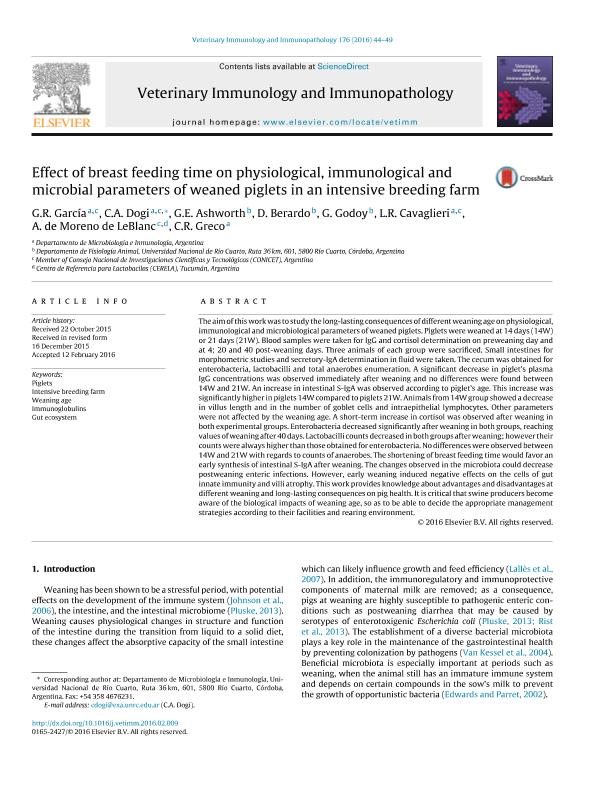Mostrar el registro sencillo del ítem
dc.contributor.author
García, Gisela Romina

dc.contributor.author
Dogi, Cecilia Ana

dc.contributor.author
Ashworth, Guillermo Edgardo

dc.contributor.author
Berardo, D.
dc.contributor.author
Godoy, G.
dc.contributor.author
Cavaglieri, Lilia Reneé

dc.contributor.author
de Moreno, Maria Alejandra

dc.contributor.author
Greco, Cecilia Rosa

dc.date.available
2018-03-19T21:17:42Z
dc.date.issued
2016-08
dc.identifier.citation
García, Gisela Romina; Dogi, Cecilia Ana; Ashworth, Guillermo Edgardo; Berardo, D.; Godoy, G.; et al.; Effect of breast feeding time on physiological, immunological and microbial parameters of weaned piglets in an intensive breeding farm; Elsevier Science; Veterinary Immunology And Immunopathology; 176; 8-2016; 44-49
dc.identifier.issn
0165-2427
dc.identifier.uri
http://hdl.handle.net/11336/39306
dc.description.abstract
The aim of this work was to study the long-lasting consequences of different weaning age on physiological, immunological and microbiological parameters of weaned piglets. Piglets were weaned at 14 days (14W) or 21 days (21W). Blood samples were taken for IgG and cortisol determination on preweaning day and at 4; 20 and 40 post-weaning days. Three animals of each group were sacrificed. Small intestines for morphometric studies and secretory-IgA determination in fluid were taken. The cecum was obtained for enterobacteria, lactobacilli and total anaerobes enumeration. A significant decrease in piglet's plasma IgG concentrations was observed immediately after weaning and no differences were found between 14W and 21W. An increase in intestinal S-IgA was observed according to piglet's age. This increase was significantly higher in piglets 14W compared to piglets 21W. Animals from 14W group showed a decrease in villus length and in the number of goblet cells and intraepithelial lymphocytes. Other parameters were not affected by the weaning age. A short-term increase in cortisol was observed after weaning in both experimental groups. Enterobacteria decreased significantly after weaning in both groups, reaching values of weaning after 40 days. Lactobacilli counts decreased in both groups after weaning; however their counts were always higher than those obtained for enterobacteria. No differences were observed between 14W and 21W with regards to counts of anaerobes. The shortening of breast feeding time would favor an early synthesis of intestinal S-IgA after weaning. The changes observed in the microbiota could decrease postweaning enteric infections. However, early weaning induced negative effects on the cells of gut innate immunity and villi atrophy. This work provides knowledge about advantages and disadvantages at different weaning and long-lasting consequences on pig health. It is critical that swine producers become aware of the biological impacts of weaning age, so as to be able to decide the appropriate management strategies according to their facilities and rearing environment.
dc.format
application/pdf
dc.language.iso
eng
dc.publisher
Elsevier Science

dc.rights
info:eu-repo/semantics/openAccess
dc.rights.uri
https://creativecommons.org/licenses/by-nc-sa/2.5/ar/
dc.subject
Gut Ecosystem
dc.subject
Immunoglobulins
dc.subject
Intensive Breeding Farm
dc.subject
Piglets
dc.subject
Weaning Age
dc.title
Effect of breast feeding time on physiological, immunological and microbial parameters of weaned piglets in an intensive breeding farm
dc.type
info:eu-repo/semantics/article
dc.type
info:ar-repo/semantics/artículo
dc.type
info:eu-repo/semantics/publishedVersion
dc.date.updated
2017-09-13T16:22:32Z
dc.journal.volume
176
dc.journal.pagination
44-49
dc.journal.pais
Países Bajos

dc.journal.ciudad
Amsterdam
dc.description.fil
Fil: García, Gisela Romina. Consejo Nacional de Investigaciones Científicas y Técnicas; Argentina. Universidad Nacional de Río Cuarto. Facultad de Ciencias Exactas, Fisicoquímicas y Naturales. Departamento de Microbiología e Inmunología; Argentina
dc.description.fil
Fil: Dogi, Cecilia Ana. Consejo Nacional de Investigaciones Científicas y Técnicas; Argentina. Universidad Nacional de Río Cuarto. Facultad de Ciencias Exactas, Fisicoquímicas y Naturales. Departamento de Microbiología e Inmunología; Argentina
dc.description.fil
Fil: Ashworth, Guillermo Edgardo. Universidad Nacional de Río Cuarto; Argentina
dc.description.fil
Fil: Berardo, D.. Universidad Nacional de Río Cuarto; Argentina
dc.description.fil
Fil: Godoy, G.. Universidad Nacional de Río Cuarto; Argentina
dc.description.fil
Fil: Cavaglieri, Lilia Reneé. Consejo Nacional de Investigaciones Científicas y Técnicas; Argentina. Universidad Nacional de Río Cuarto. Facultad de Ciencias Exactas, Fisicoquímicas y Naturales. Departamento de Microbiología e Inmunología; Argentina
dc.description.fil
Fil: de Moreno, Maria Alejandra. Consejo Nacional de Investigaciones Científicas y Técnicas. Centro Científico Tecnológico Conicet - Tucuman. Centro de Referencia Para Lactobacilos; Argentina
dc.description.fil
Fil: Greco, Cecilia Rosa. Universidad Nacional de Río Cuarto. Facultad de Ciencias Exactas, Fisicoquímicas y Naturales. Departamento de Microbiología e Inmunología; Argentina
dc.journal.title
Veterinary Immunology And Immunopathology

dc.relation.alternativeid
info:eu-repo/semantics/altIdentifier/doi/http://dx.doi.org/10.1016/j.vetimm.2016.02.009
dc.relation.alternativeid
info:eu-repo/semantics/altIdentifier/url/https://www.sciencedirect.com/science/article/pii/S0165242716300174
Archivos asociados
